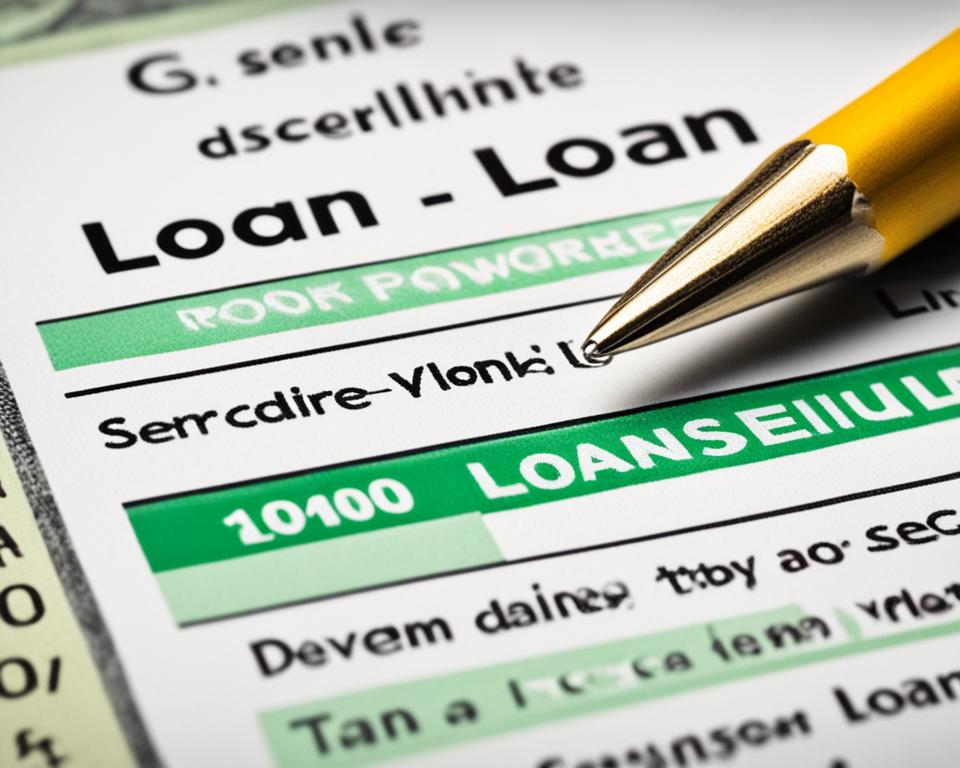Student loans are an essential part of financing higher education for many students. Understanding how student loans work and exploring the available options can help you make informed decisions about your college finances. In this article, I will provide a comprehensive overview of student loans, including the types of loans available, interest rates, application processes, and repayment options.
When it comes to student loans, you have two main options: federal and private loans. Federal student loans are issued by the U.S. Department of Education and offer borrower protections and flexible repayment plans. Private student loans, on the other hand, are provided by banks, credit unions, and online lenders, and their terms may vary.
It’s important to prioritize federal loan options before considering private loans, as federal loans often come with lower interest rates and more favorable repayment terms. . Now, let’s dive deeper into how student loans work and explore all the available options for students like you.
Key Takeaways:
- Student loans are a common way to finance higher education.
- There are two main types of student loans: federal and private.
- Federal student loans offer borrower protections and flexible repayment plans.
- Private student loans come from banks, credit unions, and online lenders.
- It’s advisable to exhaust federal loan options before turning to private loans.
Types of Student Loans
When it comes to financing your education, there are two main types of student loans to consider: federal student loans and private student loans. Each has its own set of features and benefits that can help you achieve your academic goals. Let’s take a closer look at each type:
Federal Student Loans
Federal student loans are offered by the U.S. Department of Education and are a popular choice among students due to their borrower protections and flexible repayment options. Here are the different types of federal student loans:
| Loan Type | Description |
|---|---|
| Direct Subsidized Loans | Available to undergraduate students based on financial need. The government pays the interest while you’re in school. |
| Direct Unsubsidized Loans | Available to undergraduate, graduate, and professional students regardless of financial need. Interest accrues while you’re in school. |
| Direct PLUS Loans | Designed for graduate and professional students, as well as parents of dependent undergraduate students. Requires a credit check. |
| Direct Consolidation Loans | Allows borrowers to combine multiple federal student loans into one. Simplifies the repayment process. |
Private Student Loans
Private student loans are offered by banks, credit unions, and online lenders. They can be a good option if you’ve exhausted your federal loan options or need additional funds to cover your education expenses. Here’s what you need to know about private student loans:
- Private student loans have their own lender-specific requirements and interest rates.
- Interest rates for private student loans are typically based on the borrower’s creditworthiness.
- Private student loans may offer fixed or variable interest rates.
- Private student loans may require a co-signer, especially if you have limited credit history or income.
It’s important to carefully consider your options and evaluate the terms and conditions of both federal and private student loans before making a decision. Remember to prioritize federal loans due to their favorable terms and repayment options.
Next, we’ll delve into how student loan interest works and the factors that affect the cost of borrowing.
How Does Student Loan Interest Work?
Student loan interest rates play a crucial role in determining the cost of financing your education. Let’s delve into the intricacies of student loan interest rates and how they function.
Interest on student loans is a fee imposed by the lender based on the amount borrowed. It can be either fixed or variable, depending on the type of loan and the terms agreed upon.
The interest on federal student loans starts accruing as soon as the loan is disbursed, with one exception. Subsidized federal loans, available to undergraduate students based on financial need, have a unique benefit. The government pays the interest on subsidized loans while the borrower is still in school. This can help manage the accruing interest and alleviate some financial burden.
On the other hand, private student loans generally begin accruing interest immediately after disbursement. It’s important to factor this into your repayment plan, as the interest can add up significantly over time.
The interest rates for federal student loans are determined by Congress and vary based on the type of loan. Currently, for the 2022-2023 school year, the interest rates are 4.99% for direct subsidized and unsubsidized loans for undergraduates, 6.54% for direct unsubsidized loans for graduate and professional students, and 7.54% for direct PLUS loans for graduate or professional students and parents of dependent students.
Private student loan interest rates, on the other hand, are set by individual lenders. These rates are determined based on the borrower’s creditworthiness, meaning your credit score and financial history can impact the interest rate you qualify for. Borrowers with good or excellent credit scores generally have access to more competitive rates.
Understanding how student loan interest works is crucial for making informed borrowing decisions. Be sure to carefully evaluate the interest rates, repayment options, and borrower protections offered by both federal and private lenders before committing to a loan.
“The interest on student loans is a cost that can significantly impact the total amount you’ll pay back. Be sure to compare interest rates and terms from different lenders to find the most favorable option for your financial situation.”
Student Loan Interest Rates Compared – Federal vs. Private
| Loan Type | Interest Rate (2022-2023) |
|---|---|
| Direct Subsidized Loans | 4.99% |
| Direct Unsubsidized Loans (Undergraduate) | 4.99% |
| Direct Unsubsidized Loans (Graduate/Professional) | 6.54% |
| Direct PLUS Loans | 7.54% |
| Private Student Loans | Varies by lender and creditworthiness |
Note: The interest rates mentioned for federal student loans are for the 2022-2023 academic year and are subject to change. It’s advisable to check the latest rates on the official U.S. Department of Education website or contact your loan servicer for the most accurate information.
https://www.youtube.com/watch?v=wl-EHJuXCmE
How to Apply for Student Loans
Applying for student loans is an essential step in securing the necessary funds for your college education. Whether you’re considering federal student loans or private student loans, it’s important to understand the application process and requirements.
Federal Student Loans
To apply for federal student loans, you must complete the Free Application for Federal Student Aid (FAFSA). The FAFSA collects financial information to determine your eligibility for federal aid, including grants, scholarships, and work-study opportunities. It’s crucial to submit the FAFSA as early as possible to maximize your chances of receiving financial assistance.
The FAFSA is available online at fafsa.ed.gov. You will need to create an FSA ID and gather necessary documents such as your Social Security number, tax returns, and bank statements. The application is free, and it typically takes about 30 minutes to complete.
Private Student Loans
Private student loans have their own application process, which varies by lender. Some lenders allow prequalification based on credit score, while others require a full application. It’s essential to research different lenders and compare interest rates, repayment terms, and borrower benefits before applying for private student loans.
When applying for private student loans, you may need to provide personal information, including your Social Security number, income details, and the chosen school’s information. The lender will assess your creditworthiness to determine if you qualify for the loan and what interest rate you will receive.
Comparison Table: Federal vs. Private Student Loans
| Aspect | Federal Student Loans | Private Student Loans |
|---|---|---|
| Interest Rates | Fixed rates set by Congress | Varies by lender based on creditworthiness |
| Application Process | FAFSA | Varies by lender |
| Borrower Protections | Flexible repayment options, loan forgiveness programs | Varies by lender |
| Eligibility | Based on financial need and school enrollment | Based on creditworthiness |
Comparing federal and private student loans can help you make an informed decision about which type of loan is best for you. Federal student loans often offer more borrower protections and flexible repayment options, while private student loans can provide higher loan limits and potentially lower interest rates for borrowers with strong credit history.
Now that you understand the basics of applying for federal and private student loans, you can take the next step in financing your education. Remember to exhaust federal loan options before turning to private loans, as federal loans often provide more favorable terms and benefits.
What Can Student Loans Be Used For?
When it comes to financing your education, student loans can be a valuable resource. They provide the necessary funds to cover a variety of education-related expenses, ensuring that you can focus on your studies without undue financial stress. Here are some common uses of student loans:
- Tuition: Student loans can help cover the cost of tuition, which is often the biggest expense for college students. Whether you’re attending a public university or a private college, student loans can bridge the gap between scholarships, grants, and your actual tuition bill.
- Fees: In addition to tuition, colleges and universities often charge various fees, including technology fees, library fees, and student activity fees. Student loans can be used to cover these fees and ensure that you have access to the resources and services provided by your institution.
- Books and Supplies: Course materials, textbooks, and supplies can quickly add up. Student loans can help you purchase the necessary books, notebooks, pens, and other supplies required for your classes.
- Room and Board: If you live on campus or in off-campus housing, student loans can cover the cost of room and board. This includes rent, utilities, and meal plans. It’s important to note that the cost of living varies depending on the location and housing options available.
- Technology Expenses: In today’s digital age, technology is crucial for academic success. Student loans can be used to purchase laptops, tablets, software, and other technology necessary for your coursework.
- Transportation Costs: Whether you commute to campus or need to travel home during breaks, student loans can help cover transportation costs. This includes expenses such as gas, public transportation fares, flights, or maintenance for a vehicle.
It’s important to keep in mind that the uses of student loans may vary depending on whether you have federal or private student loans. While federal student loans generally have fewer restrictions on how the funds can be used, private student loans may have more specific guidelines. It’s always a good idea to check with your lender regarding any limitations or requirements.
Remember, student loans should be used responsibly. It’s advisable to only borrow what you need and to consider other sources of financial aid, such as scholarships, grants, and work-study programs, before relying solely on student loans.

How Much Do Student Loans Cost?
The cost of student loans can vary depending on several factors, including the principal amount borrowed, interest rates, and any associated fees. Understanding the cost of student loans is essential for borrowers to make informed decisions about their education financing options.
Student loans come in two main categories: federal loans and private loans. Federal student loan interest rates are set by Congress and vary based on the type of loan, while private student loan interest rates are determined by the lender.
| Loan Type | Interest Rate | Loan Fees |
|---|---|---|
| Federal Student Loans | Varies by loan type* | Origination fees apply* |
| Private Student Loans | Determined by the lender | Additional fees may apply |
*Specific interest rates and fees may vary. Please refer to the official loan information for the most accurate and up-to-date details.
The total cost of a student loan includes the principal amount borrowed, the accrued interest over the loan term, and any applicable fees. The interest on federal student loans begins accruing at different times depending on the loan type, while private student loans typically start accruing interest as soon as the funds are disbursed.
It’s important for borrowers to compare interest rates and fees when considering both federal and private student loans. Additionally, the loan term and the amount borrowed will also impact the overall cost. Taking the time to carefully assess all of these factors can help borrowers make informed decisions and minimize the overall cost of their student loans.
Student Loan Repayment Options
When it comes to repaying your student loans, there are several strategies that can help you manage your debt effectively. Whether you have federal or private student loans, understanding the available repayment options is crucial in creating a plan that fits your financial situation.
Options for Federal Student Loans
For borrowers with federal student loans, there are several repayment plans to choose from:
- Standard Repayment: This is the default repayment plan, where you make fixed monthly payments over a 10-year period until your loan is fully paid off.
- Graduated Repayment: With this plan, your monthly payments start off lower and gradually increase over time, typically every two years.
- Extended Repayment: If you have a significant amount of debt, you may qualify for an extended repayment plan, which allows you to make smaller monthly payments over a longer repayment period, usually up to 25 years.
- Income-Driven Repayment: These plans, including income-based repayment (IBR), Pay As You Earn (PAYE), and Revised Pay As You Earn (REPAYE), cap your monthly payments at a percentage of your discretionary income and extend your repayment term. They are ideal for borrowers with lower income or high debt.
Income-driven repayment plans can be a great option if you’re struggling to make your monthly payments or if you’re pursuing a career with a lower income potential. These plans provide flexibility and can help ensure that your loan payments remain affordable as your financial situation changes over time.
Options for Private Student Loans
Private student loan repayment options can vary depending on the lender. However, here are some common options:
- Standard Repayment: Similar to federal loans, this plan requires fixed monthly payments over a set term, usually 5 to 20 years.
- Various Term Lengths: Lenders may offer different term lengths for repayment, allowing borrowers to select a time frame that works best for their financial goals.
It’s important to check with your private student loan lender to understand the repayment options available to you. Some lenders may also offer benefits or discounts for automatic payments or for making on-time payments.
A Quote on Repayment Strategies
“Repaying student loans can feel overwhelming, but by exploring the various repayment options and finding a strategy that aligns with your financial goals, you can create a manageable plan that sets you up for long-term financial success.” – Jane Smith, Financial Advisor
| Repayment Options | Eligibility | Key Features |
|---|---|---|
| Standard Repayment | Federal and Private Loans | Fixed monthly payments over a fixed term |
| Graduated Repayment | Federal Loans | Payments start low and increase over time |
| Extended Repayment | Federal Loans | Longer repayment period with smaller monthly payments |
| Income-Driven Repayment | Federal Loans | Monthly payments based on income and family size |
| Standard Repayment | Private Loans | Fixed monthly payments over a set term |
| Various Term Lengths | Private Loans | Flexible term lengths available |
Student Loan Forgiveness Programs
Student loan forgiveness programs offer a ray of hope for borrowers burdened by their loan balances. These programs provide an opportunity to have a portion or even the entirety of their remaining loan balance forgiven. However, it’s important to note that these forgiveness programs are generally available only for federal student loans, and private student loans rarely offer such programs.
There are various requirements that borrowers need to meet in order to qualify for student loan forgiveness. One common requirement is working in certain public service fields, such as government or non-profit organizations. Alternatively, borrowers may need to make consistent payments for a specific period of time before becoming eligible for forgiveness.
If you have federal student loans and meet the criteria for forgiveness programs, it’s definitely worth exploring these options. They can alleviate the financial burden and allow you to move forward with a clean slate. To find out if you qualify for any of these programs, it’s a good idea to contact your loan servicer or visit the official government websites for detailed information.
“Student loan forgiveness programs provide a light at the end of the tunnel for borrowers struggling with their loan debt. By meeting specific requirements, borrowers can have their loan balance forgiven, providing them with a fresh start.”
Student Loan Forgiveness Programs
| Program Name | Eligibility Criteria | Forgiveness Amount |
|---|---|---|
| Public Service Loan Forgiveness (PSLF) | Work in qualifying public service jobs | Remaining loan balance after 120 qualifying payments |
| Teacher Loan Forgiveness | Teach full-time in low-income schools | Up to $17,500, depending on the subject taught |
| Income-Driven Repayment Forgiveness | Make consistent payments under an income-driven repayment plan | Remaining loan balance after 20-25 years of qualifying payments |
Note: The above table provides a brief overview of some common forgiveness programs. Eligibility criteria and forgiveness amounts may vary. Please refer to the official government websites for more comprehensive and up-to-date information.
Remember, if you have private student loans, there may not be forgiveness programs available. However, that doesn’t mean you’re out of options. It’s worth exploring alternative repayment strategies or seeking assistance from your loan servicer to find solutions that can make your repayment journey more manageable.
Student Loan Options for Repayment Assistance
If you’re struggling to repay your student loans due to financial hardship, there are options available to assist you. Alongside forgiveness programs, federal student loans offer repayment assistance options that can make your repayment journey more manageable. These options aim to provide relief and flexibility to borrowers facing challenges in meeting their repayment obligations.
One of the primary repayment assistance options for federal student loans is the income-driven repayment plan. This plan adjusts your monthly loan payments based on your income and family size. It ensures that your payments remain affordable, taking into account your financial situation. Income-driven repayment plans include:
- Income-Based Repayment (IBR)
- Pay As You Earn (PAYE)
- Revised Pay As You Earn (REPAYE)
- Income-Contingent Repayment (ICR)
These plans typically require you to provide documentation of your income and family size to determine your eligibility and calculate your monthly payments. They can help alleviate the burden of high loan payments, especially if your income is limited or varies from year to year.
In addition to income-driven repayment plans, federal student loans also offer options for deferment and forbearance. Deferment allows you to temporarily postpone your loan payments, typically due to specific circumstances such as unemployment, economic hardship, or enrollment in a qualifying educational program. During deferment, subsidized federal loans may not accrue interest.
Forbearance, on the other hand, allows you to temporarily suspend or reduce your loan payments due to financial difficulties or illness. Unlike deferment, both subsidized and unsubsidized federal loans continue to accrue interest during forbearance.
It’s important to note that while these repayment assistance options can provide temporary relief, they may extend your repayment period and increase the total amount you’ll repay over time due to accumulating interest. You should carefully evaluate the pros and cons of each option, considering your long-term financial goals and circumstances.
| Repayment Option | Description |
|---|---|
| Income-Driven Repayment Plans | Adjusts monthly payments based on income and family size |
| Deferment | Temporarily postpones loan payments due to specific circumstances |
| Forbearance | Temporarily suspends or reduces loan payments due to financial difficulties or illness |
Quote:
“Repayment assistance options for student loans can provide much-needed relief for borrowers facing financial challenges, allowing them to better manage their loan payments and work towards a more secure financial future.” – Jane Smith, Financial Advisor
In conclusion, if you find yourself struggling to repay your student loans, remember that there are options available to assist you. Federal student loans offer various repayment assistance programs such as income-driven repayment plans, deferment, and forbearance. These programs can provide temporary relief while you navigate financial hardship. However, it’s essential to carefully consider the impact on the total cost and duration of your loan repayment. Reach out to your loan servicer or a financial advisor to explore these options and determine the best course of action based on your unique circumstances.
Federal Student Loan Interest Rates
The interest rates for federal student loans are determined by Congress. For the 2022-2023 school year, the interest rates are as follows:
- Direct Subsidized and Unsubsidized Loans for Undergraduates: 4.99%
- Direct Unsubsidized Loans for Graduate and Professional Students: 6.54%
- Direct PLUS Loans for Graduate or Professional Students and Parents of Dependent Students: 7.54%
These interest rates play a significant role in determining the overall cost of a federal student loan. It’s important to choose the right loan type and carefully consider the associated interest rates when making borrowing decisions.
Student loans can have a long-term impact on your financial well-being, so it’s crucial to understand the interest rates and repayment terms before taking on debt. The interest rates for federal loans may vary from year to year, so it’s essential to stay updated on the latest rates and adjust your loan decisions accordingly.
Private Student Loan Interest Rates
When it comes to private student loans, interest rates play a crucial role in determining the overall cost of borrowing. Unlike federal student loans with set interest rates, private lenders evaluate individual borrowers based on their creditworthiness to determine the interest rate they qualify for. As a result, private student loan interest rates can vary significantly from one lender to another.
If you’re considering private student loans, it’s important to note that interest rates for these loans may be higher than those offered by federal loan programs. The higher rates reflect the increased risk assumed by private lenders, as they don’t have the same level of government backing and borrower protections as federal loans.
However, borrowers with a good or excellent credit score can often secure the most competitive interest rates on private student loans. Lenders view borrowers with strong credit histories as lower risk, and therefore offer them better terms and rates. So, maintaining a good credit score and improving it whenever possible can help you secure more affordable financing options.
Comparing Interest Rates on Private Student Loans
When comparing private student loan options, it’s essential to consider the interest rates alongside other factors such as repayment terms, fees, and loan features. Here’s an example table that showcases the interest rates offered by different private lenders:
| Lender | Interest Rate |
|---|---|
| ABC Bank | 5.25% – 8.75% |
| XYZ Credit Union | 6.00% – 9.50% |
| Online Lender | 4.75% – 10.25% |
Please note that the interest rates mentioned in this table are purely hypothetical and for illustrative purposes only. The rates you qualify for will depend on various factors, including your credit history, income, and the lender’s specific criteria.
Comparing interest rates from multiple lenders allows you to find the most favorable option for your financial situation. Remember to carefully review the terms and conditions of each loan, including any fine print, to understand the full cost of borrowing before making a decision.
“It’s crucial to compare interest rates on private student loans before committing to any lender. A small difference in interest rates can make a significant impact on the total repayment amount over the life of the loan.”
By thoroughly researching and considering interest rates, you can make an informed decision that aligns with your financial goals and ensures the most affordable repayment plan.
Conclusion
Student loans provide a valuable option for financing a college education. Federal student loans offer important benefits such as borrower protections and flexible repayment options that can help individuals manage their loan obligations more effectively compared to private loans.
When considering student loans, it is essential to carefully evaluate the cost of borrowing and explore all available financial aid resources. This includes scholarships, grants, work-study programs, and other forms of assistance that can help reduce the need for borrowing.
While repayment strategies and forgiveness programs can assist in managing the cost of student loans, it is advisable to minimize borrowing and prioritize timely repayment to avoid long-term debt and financial burdens in the future. Responsible financial planning and budgeting can go a long way in minimizing the overall impact of student loans on your financial well-being.
FAQ
How do student loans work and what are my options?
Student loans are a type of installment loan that pay for college and its related costs, including tuition, fees, books, and living expenses. There are two types of student loans: federal and private. Federal student loans are available through the U.S. Department of Education and require the submission of the FAFSA. Private student loans are available through banks, credit unions, and online lenders. It’s important to exhaust federal loan options before turning to private loans.
What are the types of student loans?
There are two types of student loans: federal student loans and private student loans. Federal student loans include direct subsidized loans, direct unsubsidized loans, direct PLUS loans, and direct consolidation loans. Private student loans are available through banks, credit unions, and online lenders and have their own borrower requirements and interest rates.
How does student loan interest work?
Student loan interest is a fee charged by the lender based on the amount borrowed. It can be fixed or variable. In the case of federal loans, interest begins accruing as soon as the loan is disbursed, with the exception of subsidized loans where the government pays the interest while the borrower is in school. Private student loans typically start accruing interest as soon as the loan is disbursed.
How do I apply for student loans?
To apply for federal student loans, you must complete the Free Application for Federal Student Aid (FAFSA). The FAFSA collects financial information to determine eligibility for federal aid. Private student loans have their own application process, which varies by lender. Some lenders allow prequalification based on credit score, while others require a full application.
What can student loans be used for?
Student loans can be used to cover a variety of education-related expenses, including tuition, fees, books, supplies, room and board, technology expenses, and transportation costs. Private student loans may have limitations on how the funds can be used, so it’s important to check with the lender.
How much do student loans cost?
The cost of student loans includes the principal amount borrowed plus interest and any fees. Federal student loan interest rates are set by Congress and vary based on the type of loan. Private student loan interest rates are determined by the lender. Federal loans also have origination fees, while private loans may have additional fees. The total cost of the loan depends on the interest rate, loan term, and loan amount.
What are the repayment options for student loans?
Federal student loans offer repayment options such as standard repayment, graduated repayment, extended repayment, and income-driven repayment plans. Income-driven repayment plans tie monthly payments to income and family size. Private student loan repayment options vary by lender but typically include standard repayment and various term lengths.
Are there student loan forgiveness programs?
Yes, there are various student loan forgiveness programs available for federal student loans. These programs forgive a portion or all of the borrower’s remaining loan balance after meeting certain requirements, such as working in certain public service fields or making consistent payments for a specific period of time. Private student loans generally do not offer loan forgiveness programs.
What are the student loan options for repayment assistance?
In addition to forgiveness programs, federal student loans offer repayment assistance options, such as income-driven repayment plans and deferment/forbearance options. These programs aim to make repayment more manageable for borrowers facing financial hardship.
What are the federal student loan interest rates?
The interest rates for federal student loans are determined by Congress. For the 2022-2023 school year, the interest rates are 4.99% for direct subsidized and unsubsidized loans for undergraduates, 6.54% for direct unsubsidized loans for graduate and professional students, and 7.54% for direct PLUS loans for graduate or professional students and parents of dependent students.
What are the private student loan interest rates?
Private student loan interest rates are determined by the lender based on the borrower’s creditworthiness. Rates can vary significantly and may be higher than federal student loan rates. Borrowers with a good or excellent credit score generally qualify for the most competitive rates.





